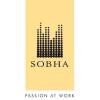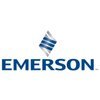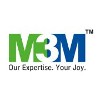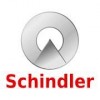Senior Project Engineer
100+ Senior Project Engineer Interview Questions and Answers

Asked in Welspun World

Q. What is the difference between MS and DI pipes?
MS pipes are made of mild steel while DI pipes are made of ductile iron.
MS pipes are cheaper than DI pipes.
DI pipes are more durable and have higher tensile strength than MS pipes.
DI pipes are used for water supply and sewage systems while MS pipes are used for gas and oil pipelines.
DI pipes have a smoother inner surface which reduces friction and improves flow rate.
MS pipes are prone to corrosion and require regular maintenance.
DI pipes are more resistant to corrosion and ha...read more

Asked in Sobha

Q. How do you read structural drawings and compare them to working drawings?
Reading structural drawings involves understanding symbols, dimensions, and materials used in the design.
Understand the scale of the drawing to ensure accurate measurements.
Identify symbols and abbreviations used in the drawing key.
Review the structural elements such as beams, columns, and foundations.
Compare the structural drawing with working drawings to ensure consistency in design and construction.
Pay attention to details such as material specifications and connections be...read more
Asked in Aman Engineering Associates

Q. Tell me something about transformer and switch gears?
Transformers and switch gears are essential components in electrical power systems.
Transformers are used to step up or step down voltage levels in power systems.
Switch gears are used to control and protect electrical equipment from overloads and short circuits.
Transformers and switch gears work together to ensure efficient and safe power transmission and distribution.
Examples of switch gears include circuit breakers, fuses, and disconnect switches.
Transformers can be categori...read more

Asked in Wipro

Q. What is Redux and how do you use it in React?
Redux is a state management library for JavaScript applications.
Redux helps manage the state of an application in a predictable way.
It uses a single source of truth, called the store, to hold the state of the application.
Actions are dispatched to the store, which then updates the state using reducers.
React components can subscribe to the store to receive updates to the state.
Redux can be used with React using the react-redux library.

Asked in Percivon Technologies

Q. Do you have a B1 Visa? If yes, what is its validity?
Yes, I have a B1 Visa with a validity of 5 years.
Yes, I have a B1 Visa
The validity of my B1 Visa is 5 years

Asked in Sobha

Q. How do you study structural drawings and apply them on a work site?
To study structural drawing and apply on work site, one must understand the symbols, dimensions, and materials used in the drawings.
Study the key symbols and abbreviations used in structural drawings.
Understand the dimensions and scale of the drawings to accurately interpret measurements.
Familiarize yourself with the materials specified in the drawings and their properties.
Practice interpreting structural drawings by working on sample projects or collaborating with experience...read more
Senior Project Engineer Jobs




Asked in Angelique International

Q. What are the standards for Reinforced Cement Concrete (RCC) work?
RCC work standards ensure structural integrity, safety, and durability in construction projects.
IS 456:2000 - Indian Standard for Plain and Reinforced Concrete, detailing design and construction practices.
ACI 318 - American Concrete Institute's guidelines for structural concrete design.
Eurocode 2 - European standard for the design of concrete structures, emphasizing safety and serviceability.
BS 8110 - British Standard for the design and construction of reinforced and prestres...read more

Asked in Angelique International

Q. What is the cost associated with specific work activities?
Cost associated with work activities includes labor, materials, overhead, and equipment expenses.
Labor costs: Wages for workers involved in the activity, e.g., engineers, technicians.
Material costs: Expenses for raw materials needed, e.g., steel for construction.
Overhead costs: Indirect costs like utilities and administrative expenses.
Equipment costs: Rental or purchase costs for machinery used in the project.
Share interview questions and help millions of jobseekers 🌟


Asked in Angelique International

Q. What is the quality plan associated with civil engineering projects?
A quality plan in civil engineering ensures project standards, compliance, and stakeholder satisfaction through systematic processes.
Define quality objectives: Establish clear goals for project deliverables, such as durability and safety standards.
Quality assurance processes: Implement regular inspections and audits to ensure compliance with design specifications.
Material selection: Choose high-quality materials that meet industry standards, e.g., using certified concrete for...read more

Asked in Amrutha projects

Q. What column size should be cast if the beam depth is?
The column size to be casted depends on the beam depth and structural requirements.
Column size should be determined based on structural calculations and design requirements.
Consider factors such as load-bearing capacity, building height, and seismic considerations.
Example: If the beam depth is 500mm, the column size may need to be 400mm x 400mm.
Consult structural engineers and refer to building codes for specific guidelines.

Asked in Barclays PLC

Q. What is involved in the process of SCADA development?
SCADA development involves designing, implementing, and maintaining systems for monitoring and controlling industrial processes.
Requirements Gathering: Identify user needs and system specifications, e.g., data acquisition from sensors.
System Architecture Design: Define the overall structure, including hardware and software components, e.g., PLCs and HMI.
Software Development: Create applications for data visualization and control, e.g., using SCADA software like Wonderware.
Int...read more

Asked in M3M India

Q. What is the weight of 12 mm plywood as per IS code?
The weight of 12 mm ply as per IS code varies depending on the type of wood used.
The weight of 12 mm ply can range from 22 to 30 kg per sheet.
The weight can also vary based on the density of the wood used.
IS code may specify a range of acceptable weights for 12 mm ply.

Asked in Vestas

Q. What is your expertise with DFIG generators?
I have extensive expertise in DFIG generators and their applications in various industries.
I have worked on the design and development of DFIG generators for wind turbines.
I have experience in troubleshooting and maintenance of DFIG generators.
I am familiar with the control systems used in DFIG generators.
I have knowledge of the latest advancements in DFIG generator technology.
I have worked on projects involving the integration of DFIG generators with the power grid.
Asked in Doiter Castings

Q. Important of engineering? How you review the drawing?
Engineering is crucial for designing, creating, and improving systems, structures, and products to meet societal needs.
Engineering is important for solving complex problems and improving efficiency in various industries.
Reviewing drawings involves checking for accuracy, completeness, and compliance with standards and specifications.
Attention to detail is crucial in reviewing drawings to ensure that the final product meets requirements.
Collaboration with other team members, su...read more
Asked in Totale Global

Q. What are the types of refractory materials?
Refractory materials are classified into three types: acidic, basic, and neutral.
Acidic refractories are made of silica and alumina, and are resistant to acidic materials.
Basic refractories are made of magnesia, dolomite, or chrome-magnesia, and are resistant to basic materials.
Neutral refractories are made of alumina, chromite, or carbon, and are resistant to both acidic and basic materials.
Asked in Eco Turnkey Solutions

Q. What is the machine bolt? Machine bolt is use in secondary members,it tighting easily.
A machine bolt is a type of fastener used in secondary members for easy tightening.
Machine bolts are typically threaded along the entire length of the shank.
They are commonly used in applications where a nut is used to secure the bolt in place.
Machine bolts come in various sizes and materials to suit different needs.
Examples of machine bolts include hex bolts, carriage bolts, and elevator bolts.
Asked in Totale Global

Q. What are the application methods of refractory materials?
Application methods of refractory include casting, gunning, ramming, and spraying.
Casting: Pouring refractory material into a mold and allowing it to solidify.
Gunning: Using a high-pressure gun to spray refractory material onto a surface.
Ramming: Packing refractory material into a form using a ramming tool.
Spraying: Applying refractory material using a spray gun or nozzle.

Asked in Obial

Q. How do you deal with customers and contractors?
I prioritize clear communication and building strong relationships with customers and contractors.
I actively listen to their concerns and needs
I am transparent about project progress and any issues that arise
I am respectful and professional in all interactions
I work collaboratively to find solutions that meet everyone's needs
I follow up promptly on any questions or concerns
For example, on a recent project, I held weekly meetings with the contractor to discuss progress and any...read more

Asked in UL Solutions

Q. What is the layer of cube filling?
The layer of cube filling refers to the material or substance used to fill the empty space inside a cube.
The layer of cube filling can vary depending on the purpose of the cube.
Common cube fillings include foam, air, liquid, or solid materials.
For example, in a foam cube, the filling layer would be foam.
In a cube filled with water, the filling layer would be liquid.
The choice of cube filling depends on factors such as insulation, weight, and structural integrity.

Asked in Zetwerk

Q. What is the procedure for bolt torque in steel bridges?
Bolt torque procedure in steel bridges involves specific torque values, sequence, and verification steps.
Use torque wrench to tighten bolts to specified torque values.
Follow specific sequence for tightening bolts to ensure even distribution of load.
Verify torque values using calibrated tools to ensure proper tension.
Consider factors like bolt size, material, and surface condition when determining torque values.
Regularly inspect bolts for any signs of loosening or corrosion.

Asked in Sobha

Q. What is the waterproof sequence and its type?
Waterproof sequence is the order in which different waterproofing materials are applied to a surface to ensure maximum protection.
Waterproof sequence typically involves applying a primer, followed by a waterproof membrane, and then a protective coating.
Examples of waterproofing materials used in sequence include primer, liquid membrane, sheet membrane, and sealants.
The type of waterproof sequence may vary depending on the surface to be waterproofed and the level of protection...read more
Asked in Essobigi Engineers

Q. What is the major difference between an NRV and an isolation valve?
NRV is a non-return valve used to prevent backflow, while an isolation valve is used to completely stop the flow of fluid.
NRV allows flow in one direction only, while isolation valve can be used to stop flow in both directions
NRV is typically used to prevent backflow in pipelines, while isolation valve is used for maintenance or emergency shutdowns
Examples: Check valve is a type of NRV, ball valve is a common type of isolation valve

Asked in Honeywell International India

Q. What plants have you commissioned, and can you provide a brief explanation of each?
Commissioned multiple plants including ABC and XYZ
Commissioned ABC plant which produced XYZ product
Managed the commissioning of XYZ plant which increased production by 50%
Implemented new technology in DEF plant resulting in improved efficiency

Asked in Sobha

Q. What is the basic sequence of construction activities from start to end?
Construction activities follow a systematic sequence from planning to completion, ensuring efficiency and safety.
1. Project Planning: Define scope, budget, and timeline. Example: Creating a project charter.
2. Design Phase: Develop architectural and engineering designs. Example: Finalizing blueprints.
3. Permitting: Obtain necessary permits and approvals. Example: Zoning and environmental permits.
4. Site Preparation: Clear and prepare the site for construction. Example: Excavat...read more
Asked in INFINITI BUILDING SOLUTIONS

Q. How do you approach problem-solving when you are stuck?
We can take out the solution by analyzing the problem, brainstorming solutions, and seeking help from colleagues or experts.
Analyze the problem and identify the root cause of the issue
Brainstorm potential solutions and evaluate their feasibility
Seek help from colleagues or experts if necessary
Consider alternative approaches or technologies
Document the process and solution for future reference

Asked in Schindler

Q. How do you handle highly sensitive customers?
Handle with care and attention to detail.
Listen actively to their concerns and needs.
Communicate clearly and regularly.
Provide frequent updates and progress reports.
Be responsive and available for questions or issues.
Ensure quality and accuracy in all deliverables.
Establish trust and build a strong relationship.
Address any issues or concerns promptly and professionally.

Asked in Percivon Technologies

Q. What do you know about Percivon Technologies?
Percivon Technologies is a leading technology company specializing in innovative solutions for the engineering industry.
Percivon Technologies focuses on providing cutting-edge solutions for engineering projects
They are known for their expertise in project management and engineering design
The company has a strong track record of successful project implementations
Percivon Technologies offers a wide range of services including consulting, design, and implementation

Asked in Angelique International

Q. What can you tell me about concrete work?
Concrete work involves mixing, pouring, and finishing concrete for various construction applications, ensuring durability and strength.
Concrete is a composite material made of cement, water, aggregates, and sometimes additives.
Proper mixing ratios are crucial; for example, a common mix is 1 part cement, 2 parts sand, and 3 parts gravel.
Curing is essential for strength; concrete should be kept moist for at least 7 days after pouring.
Different types of concrete (e.g., reinforce...read more

Asked in Angelique International

Q. What is the process for creating a work plan?
Creating a work plan involves defining objectives, tasks, timelines, and resources for project execution.
Define project objectives: Clearly outline what the project aims to achieve, e.g., 'Reduce production time by 20%'.
Identify tasks and milestones: Break down the project into manageable tasks with specific milestones, e.g., 'Complete design phase by Q1'.
Allocate resources: Determine the resources needed, including personnel, equipment, and budget, e.g., 'Assign 2 engineers ...read more

Asked in Angelique International

Q. What is the process for subcontractor billing?
Subcontractor billing involves invoicing, verification, and payment processes to ensure accurate and timely compensation for services rendered.
1. Contract Review: Understand the terms of the subcontractor agreement, including payment schedules and deliverables.
2. Invoice Submission: Subcontractors submit invoices detailing completed work, often accompanied by supporting documentation.
3. Verification: Project managers review the invoices against project milestones and delivera...read more
Interview Questions of Similar Designations
Interview Experiences of Popular Companies








Reviews
Interviews
Salaries
Users

















